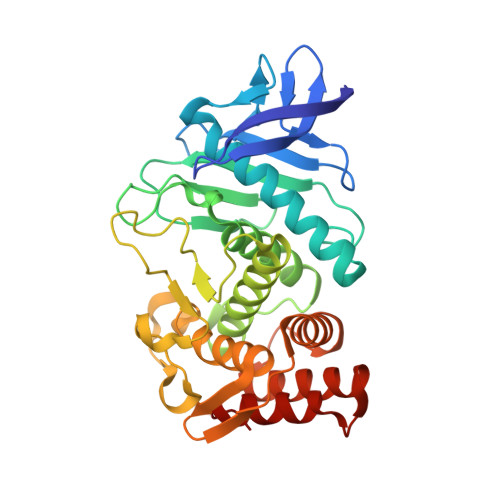Methyl, Ethyl, Propyl, Butyl: Futile But Not for Water, as the Correlation of Structure and Thermodynamic Signature Shows in a Congeneric Series of Thermolysin Inhibitors.
Krimmer, S.G., Betz, M., Heine, A., Klebe, G.(2014) ChemMedChem 4: 833-846
- PubMed: 24623396
- DOI: https://doi.org/10.1002/cmdc.201400013
- Primary Citation of Related Structures:
4MTW, 4MWP, 4MXJ, 4MZN, 4N4E, 4N5P, 4N66, 4OI5 - PubMed Abstract:
Water is ubiquitously present in any biological system and has therefore to be regarded as an additional binding partner in the protein-ligand binding process. Upon complex formation, a new solvent-exposed surface is generated and water molecules from the first solvation layer will arrange around this newly formed surface. So far, the influence of such water arrangements on the ligand binding properties is unknown. In this study, the binding modes of nine congeneric phosphonamidate-type inhibitors with systematically varied, size-increasing hydrophobic P2 ' substituents (from methyl to phenylethyl) addressing the hydrophobic, solvent-exposed S2 ' pocket of thermolysin were analyzed by high-resolution crystal structures and correlated with their thermodynamic binding profiles as measured by isothermal titration calorimetry. Overall, ΔΔG spreads over 7.0 kJ mol(-1) , ΔΔH varies by 15.8 kJ mol(-1) , and -TΔΔS by 12.1 kJ mol(-1) . Throughout the series, these changes correlate remarkably well with the geometric differences of water molecules arranged adjacent to the P2 ' substituents. Ligands with medium-sized P2 ' substituents exhibit highest affinities, presumably because of their optimal solvation patterns around these complexes. The addition, removal, or rearrangement of even a single methyl group can result in a strong modulation of the adjacent water network pattern shifting from enthalpy to entropy-driven binding. In conclusion, the quality of a water network assembled around a protein-ligand complex influences the enthalpy/entropy signature and can even modulate affinity to a surprising extent.
Organizational Affiliation:
Department of Pharmaceutical Chemistry, University of Marburg, Marbacher Weg 6, 35032 Marburg (Germany).



















